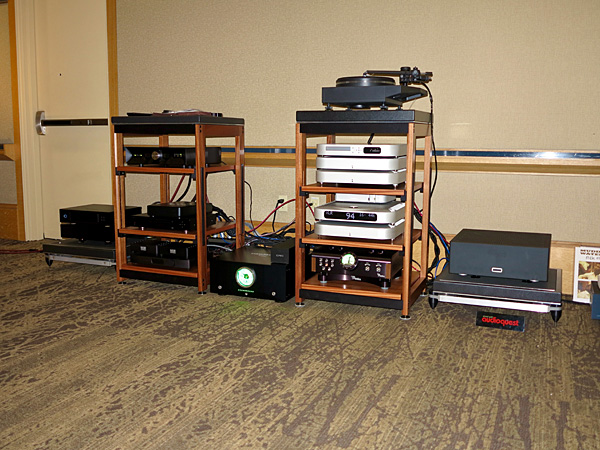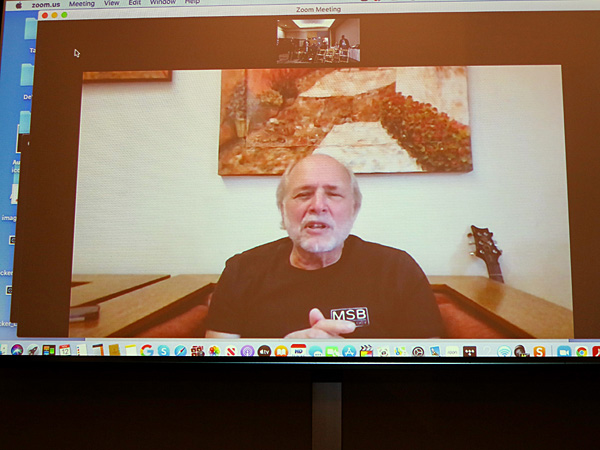| Columns Retired Columns & Blogs |
In that lead photo. Quick, put on a mask!

With Michael Fremer of Stereophile and AnalogPlanet as headline guest, the event drew a sizable number of audiophiles, some of whom brought along music from their collections including rare vinyl issues of rock, jazz, and other genres.
Nor was Mikey the only show in town. Besides the music itself, distributor Ozan Turan (Ansuz, Børresen, Vitus, Thrax and more), Magico Vice President Peter Mackay, and DeVito attended; MSB’s Vince Galbo, Rumen Artarsky of Thrax, Emile Bok and Edward Hsu of Taiko Audio, and Michael Børresen and Franc Kuzma of you-know-which companies spoke from remote locations via the web.

Two systems were on display in large, surprisingly good-sounding conference room. The first featured Børresen 01 Silver Supreme Edition loudspeakers ($55,000/pair) and the discontinued copper-wire version of Thrax Heros Mk.II 100Wpc class-A hybrid monoblocks ($36,000/pair). Both were fed by the Thrax Dionysis SE line stage with silver wiring ($23,000), MSB Discrete DAC with twin power supply (base price, $11,400), Aurender N30SA 8TB server/streamer ($24,000), and Ansuz cabling. An older Oppo served as a disc transport, and a Critical Mass System Sotto Voce rack ($6750) held everything together. Lording over the second system, where Mikey did his thing, were Magico’s S5 Mk.II loudspeakers in M-Cast bronze ($41,800/pair; footnote 1) with S-Pod8 spiked footers ($2995/set) and, hidden behind the curtain, a single QSub15 ($22,000). Between them sat a 194lb MSB S500 stereo amplifier ($58,500), whose simple design gave little indication of the 500Wpc of power (rated into 8 ohms), generated by its balanced class-AB output stage.
Occupying the right end of large rack filled with front-end equipment were the system’s essential multipiece MSB Select DAC ($105,000) and MSB Select Transport ($41,000), Taiko Extreme SGM Server Base ($29,500), Kuzma Stabi R turntable equipped with a 4Point 11 tonearm ($18,445; footnote 2) and an Ortofon Windfeld Ti cartridge ($5159). Preamplification was provided by a Boulder 508 Phono stage ($5000; footnote 3) and D’Agostino Momentum HD preamp ($40,000; footnote 4). Power and speaker cabling was top-of-the-line AudioQuest Dragon, complemented by AQ WEL interconnects. An S1000 Stromtank ($13,000) provided battery power to everything in both systems except the amplifiers.

According to Turan, audio products comprise Denmark’s 5th largest export. Each driver in the Danish Børresen 01 is loaded with pure cast silver wire. The copper-wire version of the Bulgarian Thrax Heros MkII, which made a brief appearance in my review system before being withdrawn in favor of the forthcoming silver-wire version, includes a shunt-regulated power supply and choke input rectifier intended to lower switching noise. Due to quirks in the lodge’s Ethernet set-up, music servers were out of commission until a second router could be purchased and connected. With CDs from Eva Cassidy, Dire Straits, Agnes Obel, and Bob Dylan played on an old Oppo, the system sounded strong and clean on vocals. Transients were precise, and bass was surprisingly strong and deep. When the presentation turned to LP, I didn’t find Harry Belafonte convincing as a blues singer, but I did find the sonic presentation noteworthy.

During a break, DeVito showed off his new, not-yet-available AU Ultra Diffusion room diffuser, which will be built to spec ($2000 up), and the AU Ultra Series 3000 portable power panel ($11,999; that price includes $2500 toward a power consultation), which is designed to bring ample, clean, low-impedance power to a system. The AV3000 uses the same metallurgy throughout and allows switching between A and B phase depending upon what sounds best.

MSB, which was founded in the late 1980s, issued its first discrete-ladder DAC in 1999. Galbo surprised me by explaining that MSB products are designed objectively, with little listening. “We don’t tune our DACs to a particular sound,” he said. “It’s all done by measurement, design, and theory.”
MSB moved into a new facility 18 months ago, with new CNC machines. They’re now using those machines to manufacture circuit boards robotically. Galbo said that the noise floor of the company’s DACs is not measurable with conventional gear and praised the Select DAC’s replaceable, fully upgradable plug-in input modules, which have kept it current since 2015. “The performance of our ladders and Femto clock is so far beyond what is needed for the task that we have no plans to upgrade at present,” he said.
The design for MSB’s newest amps—the mono version of the S202 is coming out very soon—strives to eliminate noise by eliminating input transistors and negative feedback. From what I heard in terms of clarity, color, texture, image size, and control, the company is doing something right. Take, for example, the first CD that Peter Mackay played through the system, on which piano and bass sounded stellar. It didn’t take long for Mikey to comment that he’d encountered many a speaker/sub presentation over the decades—Magico recommends a pair of subs for ideal stereo imagining and room-pressurizing—but this was among the best integrated unions he’d ever heard.

That was Mackay’s cue to display the software that Magico used to integrate the S5MKII with the QSub15’s dual side-firing 15" woofers. Both speakers boast the same sealed enclosure, which makes for easier integration. Work from Tel Aviv, Magico CTO Yair Tamman fine-tunes sub/tower pairings with the software depicted above. At last, it was Mikey’s turn to show us how well the system could perform under pressure. First up, fun listening to a rare lacquer of the musical intros to the Red Skelton Show, ca 1957. Then he upped the ante with Dukes Big Four. Bass was absolutely solid, hits on the drum as visceral as all get-out.
Next, a major treat: A superb pressing of Buddy Holly’s “Peggy Sue.” I entered adolescence with Buddy Holly singing in my ear, but I never had an inkling of the major changes to vocal inflection and color he employed as he sang this song. Who knew there was air and depth around the Holly’s voice and instruments, let alone reverb on the drums?
After that came increasingly complex and demanding music: a 45rpm pressing of Art Blakey and the Jazz Messengers’ “A Night in Tunisia”; a never-released 45rpm of “Stairway to Heaven”; a rare 45rpm remastering of Kenny Dorham’s Quiet Kenny from The Electric Recording Company. Instruments and voices were generous in size, bass was taut, and distortion was non-existent on the loudest and most demanding passages. Images, including those originating from the far left and right of the soundstage, floated free of the speakers. There were times when I couldn’t believe that rock and jazz could sound so good and so clear. Feet tapped, and smiles were so broad they projected through masks. Mikey, DeVito, and Mackay delivered one of the most impressive, involving, and thrilling audio demos I’ve heard in a long, long time.
Footnote 1: See John Atkinson’s review.
Footnote 2: See Ken Micallef’s review.
Footnote 3: See Michael Fremer’s Analog Corner column.
Footnote 4: See my review.

In that lead photo. Quick, put on a mask!

whatever is happening with Mikey’s leg lift.

Hi
Right !!! I am going to take my booster jab (3rd injection) next month.
Don't take it so eary. Watch out the very new "omicron" variant COV-19
virus !!!!!
Keep the mask on in the public at ALL times !
Jack L

Hi
Good news about this new deadly 'omicron' variant virus, Phizer just announced it would produce the vaccine for this dead virus in 100 days.
Let's hold our breath then.
I just took my Phizer booster jab the day before. Glad I don't have any side effect.
Jack L

Ominous stance there sunshine, and no masks!!!
For the gentile souls excuse me but I'm Aussie Cheers George
https://www.stereophile.com/images/styles/600_wide/public/1121aareport.p...

These days to design a high fidelity DAC with high-res capability, it would be ridiculous not to primarily utilized objective testing and analysis!
Impossible to make sure there's low jitter, minimal noise, and accurate linearity "by ear" alone.
I respect that MSB is clear about this. No reputable DAC company would do otherwise.

Hi
My question: HiFi music is for our ears to enjoy or for our eyes to read the specs of the hardward reproducing it ???????
If so what good is the specs of the hardware when our ears cannot HEAR accurately the "low jitter, minimalnoise & accurate linearity" ???
So should an audio consumer drop a huge bundle for something the ears cannot detect because its specs read so good to the eyes ???
So should we ASSUME huge price tags would warrant very best sound because of immaculate specs ????
Be a smart consumer, pal.
Listenig is believing
Jack L

My opinion, it takes a while, 5 minutes, maybe longer, for the brain to catch on to the minute distortions. When CDs came out, many of us were impressed and listened for a while, but we found ourselves not paying attention after 10 minutes or so. Because harmonics were wrong or not there, the rich number of sounds that make up notes was shortchanged. When we play 12 inch lp, do we realize that the last few minutes of the side are just not going to sound as good as the first few minutes? Or do we turn our attention elsewhere without knowing why? Measurements help to design better stuff.
Here is a challenge, hard to measure, is to get a small group of people to listen to the same recording played first thru a good amp with one type of distortion and then a 2nd amp with a different type. Then vote up or down if a difference was heard, and then vote preferred.

BTW: the Buddy Holly and Art Blakey were from lacquers.